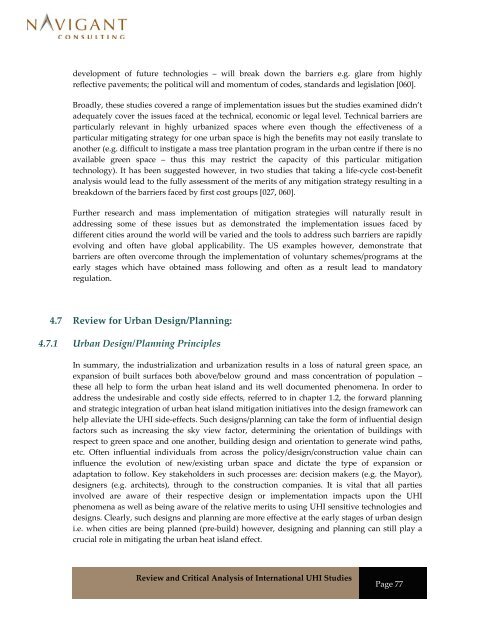Review and Critical Analysis of International UHI Studies
Review and Critical Analysis of International UHI Studies
Review and Critical Analysis of International UHI Studies
You also want an ePaper? Increase the reach of your titles
YUMPU automatically turns print PDFs into web optimized ePapers that Google loves.
development <strong>of</strong> future technologies – will break down the barriers e.g. glare from highly<br />
reflective pavements; the political will <strong>and</strong> momentum <strong>of</strong> codes, st<strong>and</strong>ards <strong>and</strong> legislation [060].<br />
Broadly, these studies covered a range <strong>of</strong> implementation issues but the studies examined didn’t<br />
adequately cover the issues faced at the technical, economic or legal level. Technical barriers are<br />
particularly relevant in highly urbanized spaces where even though the effectiveness <strong>of</strong> a<br />
particular mitigating strategy for one urban space is high the benefits may not easily translate to<br />
another (e.g. difficult to instigate a mass tree plantation program in the urban centre if there is no<br />
available green space – thus this may restrict the capacity <strong>of</strong> this particular mitigation<br />
technology). It has been suggested however, in two studies that taking a life‐cycle cost‐benefit<br />
analysis would lead to the fully assessment <strong>of</strong> the merits <strong>of</strong> any mitigation strategy resulting in a<br />
breakdown <strong>of</strong> the barriers faced by first cost groups [027, 060].<br />
Further research <strong>and</strong> mass implementation <strong>of</strong> mitigation strategies will naturally result in<br />
addressing some <strong>of</strong> these issues but as demonstrated the implementation issues faced by<br />
different cities around the world will be varied <strong>and</strong> the tools to address such barriers are rapidly<br />
evolving <strong>and</strong> <strong>of</strong>ten have global applicability. The US examples however, demonstrate that<br />
barriers are <strong>of</strong>ten overcome through the implementation <strong>of</strong> voluntary schemes/programs at the<br />
early stages which have obtained mass following <strong>and</strong> <strong>of</strong>ten as a result lead to m<strong>and</strong>atory<br />
regulation.<br />
4.7 <strong>Review</strong> for Urban Design/Planning:<br />
4.7.1 Urban Design/Planning Principles<br />
In summary, the industrialization <strong>and</strong> urbanization results in a loss <strong>of</strong> natural green space, an<br />
expansion <strong>of</strong> built surfaces both above/below ground <strong>and</strong> mass concentration <strong>of</strong> population –<br />
these all help to form the urban heat isl<strong>and</strong> <strong>and</strong> its well documented phenomena. In order to<br />
address the undesirable <strong>and</strong> costly side effects, referred to in chapter 1.2, the forward planning<br />
<strong>and</strong> strategic integration <strong>of</strong> urban heat isl<strong>and</strong> mitigation initiatives into the design framework can<br />
help alleviate the <strong>UHI</strong> side‐effects. Such designs/planning can take the form <strong>of</strong> influential design<br />
factors such as increasing the sky view factor, determining the orientation <strong>of</strong> buildings with<br />
respect to green space <strong>and</strong> one another, building design <strong>and</strong> orientation to generate wind paths,<br />
etc. Often influential individuals from across the policy/design/construction value chain can<br />
influence the evolution <strong>of</strong> new/existing urban space <strong>and</strong> dictate the type <strong>of</strong> expansion or<br />
adaptation to follow. Key stakeholders in such processes are: decision makers (e.g. the Mayor),<br />
designers (e.g. architects), through to the construction companies. It is vital that all parties<br />
involved are aware <strong>of</strong> their respective design or implementation impacts upon the <strong>UHI</strong><br />
phenomena as well as being aware <strong>of</strong> the relative merits to using <strong>UHI</strong> sensitive technologies <strong>and</strong><br />
designs. Clearly, such designs <strong>and</strong> planning are more effective at the early stages <strong>of</strong> urban design<br />
i.e. when cities are being planned (pre‐build) however, designing <strong>and</strong> planning can still play a<br />
crucial role in mitigating the urban heat isl<strong>and</strong> effect.<br />
<strong>Review</strong> <strong>and</strong> <strong>Critical</strong> <strong>Analysis</strong> <strong>of</strong> <strong>International</strong> <strong>UHI</strong> <strong>Studies</strong><br />
Page 77


